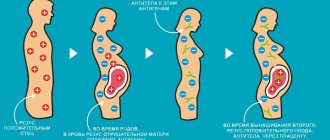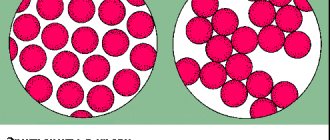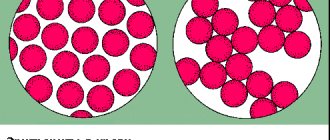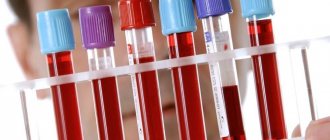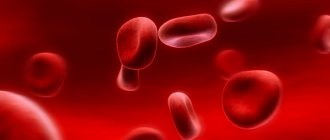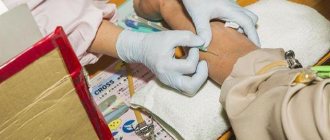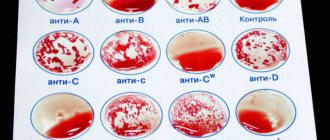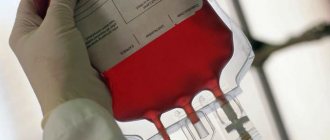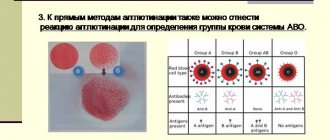Blood is one of the most important connective tissues of the human body, without which its functioning and life are impossible. Thanks to the discovery of blood groups, safe transfusion or blood transfusion became possible, which has already saved millions of people. But what determines whether blood belongs to one type or another, what types are compatible with each other, and what blood type will a child have from parents with different groups? Many of these questions can already be answered with 100% accuracy thanks to long-standing medical discoveries.
The key to the formation of a blood group is its red blood cells. These cells are not just oxygen carriers. The surface of red blood cells is covered with specific molecules - antigens. Today, a little more than 230 types of red blood cell antigens are known, which have made it possible to form 35 systems for dividing blood into different groups.
But two remain significant for transfusion: the AB0 and Rh (RhD) systems. The first classification distinguishes four blood groups based on the presence or absence of antigens A and B:
- 0 – 1 blood group, these antigens are completely absent;
- A – blood group 2, bodies have only antigen A;
- B – blood group 3, red blood cells have antigen B;
- AB – blood group 4, red blood cells have both antigens.
According to statistics, the most common are the first positive and second positive blood groups. Among the world's population, they account for about 40 and 34% of carriers, respectively. Rare blood groups are third negative and fourth negative: only 1% of people each have a similar set of antigens in their red blood cells.
The Rh (RhD) system divides the above groups according to the type of Rh factor: positive or negative. Rhesus is determined by the presence of the D antigen. According to statistics, it is absent in approximately 15% of people, which is why they have a Rh-negative blood group.
To initially determine the blood group, fairly simple laboratory procedures are performed. Anti-A and anti-B zoclions are applied to a special tablet, which are then mixed with a drop of the patient’s blood being tested.
After this, the laboratory assistant observes the reaction and draws conclusions about whether the blood belongs to one group or another. To determine the Rh factor, a similar procedure is carried out, in which anti-D tsoklion acts as a marker.
Blood group determination
It is noteworthy that some doctors performed blood transfusions back in the 17th century. However, this had little to do with medical research and actual treatment of people.
For example, the French doctor Jean-Baptiste Denis treated aggressive patients with mental disorders by transfusing them with the blood of lambs. According to the doctor, the gentleness of the cute animal was supposed to soften the patient’s violent temper. Fortunately, the court prohibited such methods of treatment.
However, Themis’s decision was made only after one of Denis’s charges died after a dangerous manipulation.
In the 19th century, blood transfusion was actively pursued in England. The first successful blood transfusion in Russia was carried out in 1832. As a result of the manipulation, G. Wolf managed to save a patient with uterine bleeding that occurred after a difficult birth.
Naturally, transfusions often ended in complications, because no one determined the compatibility of blood groups. The conditions for compatibility of blood of different patients were considered only at the beginning of the 20th century.
Karl Landsteiner
The Austrian immunologist Karl Landsteiner first drew attention to the individual differences in human blood.
He confirmed his assumptions experimentally, mixing the blood serum of some patients with red blood cells from other donors.
The aggregation reactions of components, which manifested themselves in some cases, made it possible to identify 4 blood groups, which became the basis of the AB0 system. Later, in 1930, Landsteiner received the Nobel Prize for his invaluable discoveries.
The compatibility of the blood groups of the donor and the patient is clearly presented in the table:
Blood groups: transfusion compatibility table
Thus, the owner of the first blood group is a universal donor, and the owner of the fourth is a universal recipient.
Child's blood type: principles of inheritance of antigens
Blood type and Rh factor are heritable traits, the transmission of which is subject to the laws of genetics. Therefore, knowing the blood types of the parents, it is possible to calculate with great accuracy the options for what blood type the child will have.
Most human genes are present in the body in two copies. Each parent passes on one replica to the heir, which is selected randomly.
For example, the owner of blood group 4 with antigens A and B will give the child a copy of A or B, the carrier of group 2 with alleles A and 0 will pass on antigen A to the offspring, or the baby’s red blood cells will not have the antigen at all.
More clearly, the possible variants of the child’s blood type are presented in the table:
Child's blood type: inheritance table from parents
But there are also rare exceptions, when the baby exhibits a set of genes that is distinguishable from that calculated by science. Such cases are called the “Bombay phenomenon” and occur no more often than one case per 10 million people.
Since alleles are selected randomly during genotype transfer, a situation may arise when the child receives from the father an antigen that is not present in the mother and can be perceived by her body as foreign.
An immunological conflict between blood groups arises, which can make the course of pregnancy less rosy. Fortunately, such incompatibility usually occurs quite easily and does not require special treatment.
But when planning a child, it is better to familiarize yourself with the compatibility table of the blood groups of the father and mother in advance.
Compatibility table of mother and father by blood type
More serious for the expectant mother and the unborn baby is the so-called Rh conflict. If a woman with negative Rhesus carries a child with positive Rhesus, her body may begin to produce antibodies that are aggressive towards the baby’s red blood cells.
Since during childbirth some of the baby’s blood enters the mother’s circulatory system, the woman’s immune system begins to intensively produce antigens that accumulate in the body.
Therefore, each subsequent pregnancy with an Rh-positive child may be more difficult than the previous one, and antibodies will have a stronger effect on the development of the fetus.
Rh conflict between mother and child: table
Fortunately, special therapy has been developed to alleviate the immunological Rh conflict and create normal conditions for fetal development. Additionally, immediately after childbirth, mothers can be given a drug containing anti-Rh antibodies, which prevent the woman from immunizing and destroy foreign Rh-positive red blood cells.
The human body is an amazing mechanism, delicately working according to its own unique laws. Therefore, it is very important to take a responsible approach to pregnancy planning and try to take into account any possible risks of complications. And don’t forget about the importance of donation, because just one trip to a blood donation center can save someone’s life.
General principles of inheritance of characters.
Simply put, every trait in the body (hair color, eye color, blood type, Rh factor) is encoded by two genes.
In reality, the number of genes that determine the trait is much greater. For each trait, the child receives one gene from the mother, another from the father. In genetics, dominant and recessive genes are distinguished. The dominant gene is designated by a capital letter of the Latin alphabet, and in its presence the recessive gene, as a rule, does not manifest its properties. A recessive gene is indicated by a capital letter of the Latin alphabet. If for some trait an organism contains two identical genes (two recessive or two dominant), then it is called homozygous for this trait. If an organism contains one dominant and one recessive gene, then it is called heterozygous for this trait, and at the same time those properties of the trait that are encoded by the dominant gene are manifested. For example: A is a dominant gene that determines brown eye color and A is a recessive gene that determines blue eye color
Possible genotype options: AA - homozygote, brown eyes Aa - heterozygote, brown eyes aa - homozygote, blue eyes
Example 1:
wife AA - homozygous, brown eyes, both genes are dominant; husband AA - homozygous, blue eyes, both genes are recessive
When germ cells (egg and sperm) are formed, one gene goes into each germ cell (gamete), i.e. in this case, the female body forms two gametes containing one dominant gene each, and the male body forms two gametes containing one recessive gene each. When germ cells merge, the embryo receives one maternal and one paternal gene for this trait.
wife AA + husband aa Gametes: A A a a Child: Aa Aa Aa Aa
Thus, in this situation, 100% of the children will have brown eyes and be heterozygotes for this trait.
Example 2:
wife Aa - heterozygote, brown eyes husband Aa - heterozygote, brown eyes wife Aa + husband Aa gametes: A a A a child: AA, Aa, Aa, aa
In this case, the probability of having children with brown eyes (homozygotes) is 25%, heterozygotes are 50% with brown eyes, and blue eyes (homozygotes) are 25%.
Example 3:
wife Aa - heterozygote, brown eyes husband aa - homozygote, blue eyes Wife Aa + husband aa Gametes: A a a a Child: Aa, Aa, aa, aa
In this case, 50% of children have brown eyes and are heterozygotes and 50% have blue eyes (homozygotes)
Characteristic
The owner of the second group has the ability to get along with almost any person in society. People with this blood type are modest, decent, and neat. They treat each other and others with respect and are law-abiding.
Experts believe that if there had been no division into blood groups, society would have consisted of aggressive, evil people. It was the appearance of carriers of the second group that became a decisive step towards the development of humanity.
Such people are also characterized by empathy not only for loved ones, but also for others. They are efficient, demanding of themselves and their subordinates.
They prefer to do work together, which has become a key point in the development of agriculture and the division of people into communities.
Holders of the A-group will easily give up leadership, without considering themselves unworthy of it. They most often dream of a high destiny, but carefully hide it. By the way, this condition is harmful to health and contributes to the development of depression and stress.
A carrier of the second group can work as a teacher, doctor or social worker. Has leadership qualities, but does not strive to be above others.
Patterns of inheritance of blood group and Rh factor.
Inheritance of blood type is controlled by an autosomal gene. The locus of this gene is designated by the letter I, and its three alleles by the letters A, B and 0. Alleles A and B are equally dominant, and allele 0 is recessive to both of them. There are four blood types. The following genotypes correspond to them: First (I) 00 Second (II) AA; A0 Third (III) BB; B0 Fourth (IV) AB
Example 1:
wife has the first blood group (00) husband has the second blood group and is homozygous (AA) wife 00 + husband AA gametes: 0 0 A A child: A0 A0 A0 A0
All children have a second blood group and are heterozygotes for this trait.
Example 2:
wife has the first blood group (00) husband has the second blood group and is a heterozygote (A0) wife 00 + husband A0 gametes: 0 0 A 0 child: A0 A0 00 00
In a given family, in 50% of cases it is possible to have a child with a second blood group, and in 50% of cases the child’s blood type will be first.
Inheritance of the Rh factor is encoded by three pairs of genes and occurs independently of the inheritance of blood type. The most significant gene is designated by the Latin letter D. It can be dominant - D, or recessive - d. The genotype of a Rh-positive person can be homozygous - DD, or heterozygous - Dd. The genotype of a Rh negative person may be dd.
Example 1:
wife has a negative Rh factor (dd) husband has a positive Rh factor and is a heterozygote (Dd) wife dd + husband Dd gametes: dd D d child: Dd Dd dd dd
In a given family, the probability of having a Rh-positive child is 50% and the probability of having a Rh-negative child is also 50%.
Example 2:
wife has a negative Rh factor (dd) husband has a positive Rh factor and is homozygous for this trait (DD) wife dd + husband DD gametes: dd DD child: Dd Dd Dd Dd
In this family, the probability of having a Rh-positive child is 100%.
Nutrition
For the human body with the second blood group, it is important to receive a maximum of minerals and vitamins with food. Since such people are predisposed to vegetarianism, the basis of the diet should be fruits, vegetables, and grains. It is better to eat them fresh, without heat treatment, however, you should not get too carried away with a raw food diet.
- Blood type of parents and children - how to determine what the child will have
In table 4 clearly shows what should be consumed to maintain health and proper functioning of all organs.
Table 4. Healthy and harmful foods for people with blood type II
| Product categories | Healthy foods | Harmful products |
| Vegetables | Almost everything, especially carrots, beets, cucumbers, bell peppers, broccoli. | Pickled vegetables and pickles |
| Moderate: tomatoes, eggplants, white cabbage, potatoes | ||
| Fruits and berries | Almost everything: apples, peaches, kiwi, apricots, grapes, strawberries | All sour varieties and types, as well as citrus fruits: lemons, grapefruits, oranges |
| Meat | Moderately dietary varieties: rabbit, chicken, turkey. It is better to steam, bake or boil | All fatty types (lamb, pork) |
| Fish and seafood | Lenten types | All fatty varieties |
| Cereals, grains and legumes | All types of cereals: buckwheat, rice, millet, pearl barley, etc. Legumes – soybeans, beans, lentils | |
| Beverages | Fruit juices, tea, natural coffee | Alcohol, orange juice |
| Milk and dairy products | Limited – natural yogurt, low-fat cottage cheese, hard cheese | Almost all dairy products |
It is also better to exclude hot sauces, mayonnaise, and confectionery from the diet.
Features of the course of pregnancy with Rh factor incompatibility. Rhesus conflict.
Hemolytic disease of the fetus and newborn is a condition that occurs as a result of incompatibility of the blood of mother and fetus for certain antigens. Most often, hemolytic disease of the newborn develops due to Rh conflict. In this case, the pregnant woman has Rh-negative blood, and the fetus has Rh-positive blood. During pregnancy, the Rh factor with the red blood cells of the Rh-positive fetus enters the blood of the Rh-negative mother and causes the formation of antibodies to the Rh factor in her blood (harmless to her, but causing the destruction of the fetal red blood cells). The breakdown of red blood cells leads to damage to the liver, kidneys, brain of the fetus, and the development of hemolytic disease of the fetus and newborn. In most cases, the disease develops quickly after birth, which is facilitated by the entry of a large number of antibodies into the baby’s blood when the integrity of the placental vessels is disrupted.
Less commonly, hemolytic disease of the newborn is caused by group incompatibility of the blood of mother and fetus (according to the AB0 system). In this case, due to agglutinogen (A or B), present in the fetal red blood cells but absent in the mother, antibodies to the fetal red blood cells are formed in the maternal blood. Most often, immune incompatibility manifests itself when the mother has blood group I, and the fetus has blood group II, and less often, blood group III.
The process of immunization of a pregnant woman begins with the formation of antigens in the red blood cells of the fetus. Since antigens of the Rh system are contained in the blood of the fetus from the 9-10th week of pregnancy, and group antigens - from the 5-6th week, in some cases early sensitization of the mother’s body is possible. The penetration of antigens into the maternal bloodstream is facilitated by infectious factors that increase the permeability of the placenta, minor injuries, hemorrhages and other damage to the placenta. As a rule, the first pregnancy in an Rh-negative woman, in the absence of previous sensitization of the body, proceeds without complications. Sensitization of the body of a Rh-negative woman is possible through transfusions of incompatible blood (carried out even in early childhood), during pregnancy and childbirth (if the fetus has Rh-positive blood), after abortions, miscarriages, and operations for ectopic pregnancy. According to the literature, after the first pregnancy, immunization occurs in 10% of women. If a woman with Rh-negative blood avoided Rh immunization after her first pregnancy, then during a subsequent pregnancy with an Rh-positive fetus, the probability of immunization again is 10%. Therefore, after any termination of pregnancy in a woman with Rh-negative blood, it is necessary to administer anti-Rhesus immunoglobulin for prophylactic purposes. During pregnancy, in a woman with Rh-negative blood, it is necessary to determine the titer of Rh antibodies in the blood over time.
Genetic background
The second group is designated as A(II) in the AB0 system. The group differs from others in the presence of only red blood cell A-antigens.
In order for properties to be inherited, one of the parents must have this antigen.
This means that the following combinations are possible:
- second + fourth;
- second or fourth + first (without antigens);
- second or fourth + third.
A child with the second group will not be born to parents with a combination of the first and third, since they both do not have the A-antigen. This combination indicates the absence of maternity or paternity and is used in forensic research.
Question 2:
I have a negative Rh factor. I recently had an abortion. Will I be able to have children? Is there a chance that the baby will be sick during the next pregnancy?
Answer
: The presence of a negative Rh factor does not directly affect conception. During an abortion (if it was performed at 9-10 weeks of pregnancy), there was a possibility of sensitization of the body to the Rh factor. Before a planned pregnancy, it is advisable to do a blood test for the presence of antibodies to the Rh factor.
Health Risk
Proponents of the theory that health depends on blood type believe that for A(II), attention should be paid to the following factors:
- decreased immunity, which easily occurs due to stress, infectious diseases, physical activity, and nutritional disorders;
- tendency to thrombosis, increased blood clotting;
- decreased acidity of gastric juice, impaired absorption of proteins and fats.
Such features can be deciphered as a tendency to the occurrence of such problems:
- diseases of the cardiovascular system;
- allergic manifestations, autoallergic diseases (rheumatoid polyarthritis, lupus, hepatitis, psoriasis);
- exposure to food infections, gastritis, pancreatitis;
- risk of malignant tumors.
Question 3:
What dose of anti-Rhesus immunoglobulin and in what time frame is administered to a woman with Rh-negative blood after childbirth? Is it true that the administered dose of the drug should be increased after a caesarean section?
Answer
: Women with Rh-negative blood after childbirth are given anti-Rhesus immunoglobulin in an amount of 1-1.5 ml (200-300 µg) no later than 24-48 hours after birth for prophylactic purposes. During surgical interventions, transplacental bleeding may increase, and therefore the administered dose of anti-Rhesus immunoglobulin is increased by 1.5 times.
Interesting Facts
As already mentioned, there are 2 types of blood - positive or negative. The most common option is the first. 2 positive blood group, the characteristics of which will be presented below, is present in a larger number of the population around the world.
It is noted that this type of blood appeared only after the 1st. Some suggest that this is related to the development of humanity. Primitive people were able to eat carbohydrates. They began to engage in gathering and farming. During this, the 2nd blood group was formed.
If you briefly describe people with this “substance”, you will notice that they are sociable and flexible. In addition, they tend to idealize the world. People with blood type 2 are excellent organizers.
